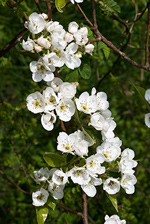|
||||||
|
PYRUS. Pears. [Rosaceae] |
|
|
Five species of Pyrus are recorded in Britain. These include Pear (P. communis). The BSBI provide a downloadable plant crib for Pyrus. Twenty-seven British miners are recorded on Pyrus. A key to the European miners recorded on Pyrus is provided in Bladmineerders van Europa. |
|
|
Key for the identification of the known mines of British |
1a > Leaf-miner and case-bearer: The larva lives outside the mine, protected by a case, and feeds on the underlying plant tissues via a hole cut in the epidermis. From that point it eats away as much leaf tissue as it can reach without fully entering the mine. Mine does not contain frass (Coleophora species) |
1b > Leaf-miner, but not a case-bearer: The larva lives mainly inside the mine. Mine usually contains frass. In later instars the larva may live sandwiched between two more or less circular sections cut from the leaf. |
2a > Leaf-miner and case-bearer: The early case is tiny and the larva makes a series of tiny holes on the leaf. After overwintering it makes a shiny pistol shaped case in spring and window feeds. The young larva, before hibernation, makes tiny mines, sometimes tens in one leaf. After hibernation window feeding is done. In this latter stage the larva lives in a shining black pistol case of about 7 mm, that, with a mouth angle of 70°-80°, stands almost perpendicular on the leaf. |
|
Coleophora anatipenella (Hübner, 1796) [Lepidoptera: Bucculatricidae]. |
2b > Leaf-miner and case-bearer: The full grown larva lives in a dull black pistol case of c 9 mm that, with a mouth angle of 80-90° stands erect on the leaf. Characteristic is the presence of some ear-like flaps. At least after the hibernation the larvae do not mine any more, but rather cause skeleton feeding. |
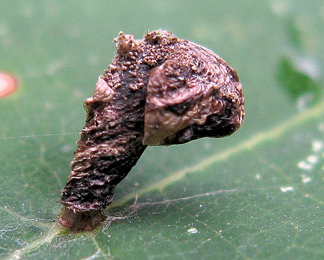 Case of Coleophora currucipennella on Quercus rubra Image: © Paul van Wielink (Bladmineerders van Europa) |
|
Coleophora currucipennella Zeller, 1839 [Lepidoptera: Coleophoridae]. |
2c > Leaf-miner and case-bearer: The species spends two years as a larva, the first one-and-a-half years in a small pistol-case, and in the second spring building a long straight case which is dark brown and rather distinctive. The lava lives from autumn until summer next year. In autumn a composite leaf case is made, shaped like the handle of a walking stick. Early in the following spring a tubular leaf case is made that in the end is rather large (10 mm) and is positioned vertically on the leaf; mouth angle 90°. |
|
Coleophora hemerobiella (Scopoli, 1763) [Lepidoptera: Coleophoridae]. |
2d > Leaf-miner and case-bearer: Larva in autumn forming a few small mines. Feeding restarts in the same case in spring before changing to a new case by late April. In spring the cases or mines cannot be reliably separated from those of C. coracipennella or C. prunifoliae. The larva lives two years. In the first year, in autumn, a composite leaf case is made that resembles a boomerang: front and rear end stand at almost right angles. In its second year the larva makes a trivalved tubular leaf case of about 6 mm, with a mouth angle of c. 45°; the case tapers somewhat to both ends. |
|
Coleophora spinella (Schrank, 1802) [Lepidoptera: Coleophoridae]. |
2e > Leaf-miner and case-bearer: The larva feeds on a wide range of trees, shrubs and herbs, favouring Rosaceae, but not exclusively. The fully developed cased larva may be found active in October and again, after winter diapause, in April. Cases, about 6 mm, of diapausing larvae may be found through winter, fixed to a tree or fence post. The dorsal surface of the case is usually covered in leaf fragments, but they can sometimes be worn off almost smooth. The ventral surface is swollen at the middle and has a keel, which usually bends upwards at the posterior. The cases of C. ahenella (on Rhamnus, Frangula, Viburnum and Cornus) and C. potentillae (case less swollen, keel not bent up, resting position less prone) are very similar. Brownish lobe case that lies almost flat on the leaf, either on the upper or on the lower side. Case widest about the middle. Ventrally there is a distinct keel. Mouth angle 0°. Full depth mines rather large. The flaps of cuticular tissue that serve to enlarge the case are cut out of the upper epidermis. (contrary to C. ahenella and C. potentillae, that use tissue from the lower epidermis). The removal of these tissue flaps creates holes that are much larger than those that serve as the entrance to the mine. |
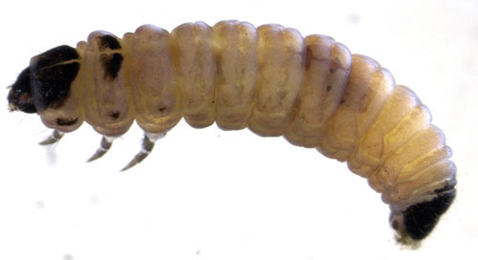 Coleophora violacea larva, lateral Image: © Willem Ellis (Bladmineerders van Europa) |
|
Coleophora violacea (Ström, 1783) [Lepidoptera: Coleophoridae]. |
3a > Leaf-miner: The larvae initially mining the leaves in a short, contorted gallery. As the larva develops it leaves the mine to feed externally, creating windows on the upperside of the leaves. Oviposition at the leaf upperside, egg shell iridescent. Small, hook-like corridor, mostly in a vein axil. Frass in a very thick central line. The larva soon leaves the mine through an untidy hole and subsequenty feeds living freely on the leaf. Pupation occurs in a ribbed white cocoon spun on debris. The winter is passed in this stage.. |
|
Bucculatrix bechsteinella (Bechstein & Scharfenberg, 1805) [Lepidoptera: Bucculatricidae]. |
3b > Leaf-miner: The young larvae mine the leaves, causing a gallery followed by a semi-translucent blotch on the upper surface of the leaf. It then vacates this and folds the edge of a leaf down to feed within, usually twice, before pupating externally among detritus. The mine begins as an inconspicuous epidermal corridor, mainly recognisable by its reddish brown frass line. In the next instar a blotch is formed. The mine not starting over a vein, rather lies between two veins. The colour initially is silvery, but soon the mine gets a characteristic onrange-brown tinge. Usually, but by no means invariably, the mine is upper-surface; lower-surface mines keep their original silvery colour. Silk is deposited witihin the mine, but in little quantities and the mine contracts only lightly. The mine hardly contains any frass. After some time the larva leaves the mine and then lives free in a leaf margin that has been folded downwards and fixed with silk. Two such folds are usually made, and eaten out to the upper epidermis. |
|
Callisto denticulella (Thunberg, 1794) [Lepidoptera: Gracillariidae]. |
3c > Leaf-miner: The larvae form galleries along the edge of the leaf, leading to the development of large blotches on the leaf margin. Oviposition on the leaf underside. There begins a full depth corridor that gradually widens into an irregular elliptic blotch. Generally the corridor part for a large stretch follows the leaf margin. If oviposition occurred well away from the leaf margin, the corridor starts by making some irregular loops around the oviposition site; however, when, as often occurs, the egg is placed close to the leaf margin, at once the leaf margin is mined. Frass blackish brown (rarely brown) in the corridor, black in the blotch. In the corridor the frass lies in lumps or indistinct coils; in the blotch the frass is irregularly dispersed. Pupation outside the mine; exit slit in the upper epidermis, contrary to Bohemannia pulverosella, with which atricollis may co-occur on Apple. |
|
Ectoedemia atricollis (Stainton, 1857) [Lepidoptera: Nepticulidae]. |
3d > Leaf-miner: The larva starts making a corridor of a few mm, followed, and mostly overrun, by a circular blotch of 4-5 mm diameter. Generally several larvae feed in a single leaf, creating a distinctive pattern of feeding windows. The larvae then cut out circular cases and drop to the leaf-litter to continue feeding, leaving behind a leaf containing many circular or oval cut-outs. |
|
| Incurvaria pectinea Haworth 1828 [Lepidoptera: Incurvariidae]. |
3e > Leaf-miner: A circular or oval brownish blotch with a central spiral of dense blackish frass (British leafminers), sometimes several mines in one leaf. Oviposition is at the leaf underside, well away from the leaf margin; the egg has a fine reticulate surface. The mine is a rather large, perfectly circular blotch without a trace of a preceeding corridor. Around the dark centre the frass, glued to the upper epidermis is arranged in distinct arcs. Pupation in a silken cocoon, usually on detritus. |
|
Leucoptera malifoliella (O. Costa, 1836) [Lepidoptera: Lyonetiidae]. |
3f > Leaf-miner: A long, whitish smoothly-curved upper-surface mine with broken black frass. Oviposition is by means of an ovipositor; what remains is a small scar: no egg shell is visible at the start of the mine. From here a long, sometimes very long, slender, full depth corridor winds throught the leaf, not steered by leaf margin or the leaf venation. The midrib is crossed effortless; the corridor frequently also crosses itself; the section of the leaf cut off then usally turns brown and dies off. Frass in a narrow central line. The larva vacates the mine prior to pupation through an exit in the upper epidermis. The vacated larval chamber is proportionally much longer than in the case of Stigmella mines ( > 3 x longer than broad). Pupation in a silken cocoon suspended from threads attached to food plant or other vegetation. |
| Polyphagous. On numerous genera and species in several plant families, but not yet on Pyrus, in Britain. On numerous genera and species in several plant families, including Pyrus, elsewhere. Widespread in Britain and continental Europe. Also recorded in the Republic of Ireland. |
Lyonetia clerkella (Linnaeus, 1758) [Lepidoptera: Lyonetiidae]. |
3g > Leaf-miner: The larva mines the leaves of various roseaceous trees, such as blackthorn and apple, forming a gallery leading to a blotch. Eggs are deposited in the underside of a leaf, well away from the margin, often several per leaf. Around the oviposition site a cavity develops that in the end often leaves a hole in the leaf. Then a narrow, hardly widening, winding corridor, largely filled with a broad reddish brown frass line. The corridor abruptly widens into a wide, full depth blotch, that often lies against the leaf margin. The larva may leave its mine and continue elsewere, even on a different leaf. Note that the first blotch may already lie on a different leaf. Frass dispersed, in oval granules. Most frass is ejected through semicircular cuts along the outer limit of the blotch; part of it is often trapped in strands of silk under the leaf. The pupal cocoon is suspended from silken 'guy ropes' and closely resembles that of L. clerkella. |
|
Lyonetia prunifoliella (Hübner, 1796) [Lepidoptera: Lyonetiidae]. |
3h > Leaf-miner: The mine is in the upper epidermis of a leaf, usually over midrib or vein. The mine is at first silvery, later with brown speckling. Silvery, upper-surface, epidermal tentiform mine, centered over the midrib or a heavy lateral vein. Unlike P. leucographella, with which this species shares some host plants, the upper epidermis looks dirty by the presence of numerous fine black-brown specks of frass. The epidermis remains without folds until the mine becomes strongly contrated. Young mines look like a streak of silver on top of a vein. |
|
Phyllonorycter corylifoliella (Hübner, 1796) [Lepidoptera: Gracillariidae]. |
3i > Leaf-miner: The mine is upper side and silvery, over the midrib. Leaf later may fold upwards, concealing the mine. Oviposition is on the base of the midrib. From there an epidermal corridor is made, running towards the leaf tip. The corridor then is widened into an epidermal, silvery blotch, finally into a longitudinally contracted tentiform mine. Frass in fine, shining grains, mostly in a line over the midrib, rarely in a mass in a corner of the mine. The epidermis of the mine has a number of yellow spots, but never the black specks that are apparent in P. corylifoliella. |
|
Phyllonorycter leucographella (Zeller, 1850) [Lepidoptera: Gracillariidae]. |
3j > Leaf-miner: Lower-surface, yellow-green tentiform mine, 20-32 mm long, with a number of fine folds in the lower epidermis. In most cases the mine is elongate, situated between two lateral veins. The reddish to chestnut brown pupa lies in a flimsy cocoon in which no frass is incorporated: the frass is stored not in a clump but in a row of loose grains behind the cocoon. Just before edcysis the pupa works itself out of the mine through the lower wall; mostly the empty exuvium sticks halfway out of the mine. |
 Mine of Phyllonorycter mespilella on Sorbus Image: © Martin Gray (British leafminers) |
|
Phyllonorycter mespilella (Hübner, 1805) [Lepidoptera: Gracillariidae]. |
3k > Leaf-miner: The mine is often in the lobe of the leaf. There are many creases in lower epidermis, which is strongly contracted, causing lobe or leaf-edge to fold over. Rather small, lower-surface, tentiform mine with a yellow-green epidermis that has a number of folds. Pupation within the mine. The pupa of the summer generation in a quite flimsy cocoon; in the autumn generation there is more, golden, silk. All frass in a clump in the distal angle of the mine. |
|
Phyllonorycter oxyacanthae (Frey, 1856) [Lepidoptera: Gracillariidae]. |
3l > Leaf-miner: A large mine with a strong crease in lower epidermis. Leaf-edge often folded downwards. Lower-surface, yellow-green tentiform mine with a few sharp folds in the epidermis. In Rowan the mine is parallel to the leaf margin, in Cherry usually between two lateral veins. The light brown cocoon lies in a wide cocoon, in which no frass is incorporated; all frass is accumulated in a clump in an angle of the mine. Before hatching the pupa penetrates the mine wall; generally the exuvium remains stuck halfway out of the mine. |
 Phyllonorycter sorbi pupa, cremaster, dorsal Image: © Willem Ellis (Bladmineerders van Europa) |
|
Phyllonorycter sorbi (Frey, 1885) [Lepidoptera: Gracillariidae]. |
3m > Leaf-miner: The mine is an underside, strongly creased blister, causing a distinct pucker in the upperside of the leaf. Elongated, lower surface, tentiform mine with one strong fold in the lower epidermis. Pupa in a white cocoon, in which no frass in incorporated; all frass in a clump in the mine. Before ecdysis the pupa works itself out of the mine through the floor in the mine. Difficult to distinguish between P. cydoniella and P. blancardella on the basis of mine characteristics - both form arched tubes on the leaf of M. sylvestris. P. cydoniella tends to make the larger mine on M. sylvestris and the pupa is in a cocoon, with frass to one side. |
|
Phyllonorycter hostis Triberti, 2007 [Lepidoptera: Gracillariidae]. |
3n > Leaf-mine: The young larvae make very small (≤ 3 mm) corridor or blotch mines, usually several in a leaf. The primary mine generally lies adjacent to the midrib; as far as I have seen the egg always is upper-surface. The secondary mines often are found in leaves without primary mine: obviously the larvae easily move to another leaf. The secondary mines are made from the underside of the leaf; while moving around silk is deposited under the leaf. Most frass is ejected from the mines, and part of the frass grains remain stuck in the spinning. Rather soon the larvae start living completely free in a common spinning under a leaf. They hibernate in a hibernaculum and continue living free in the spring. |
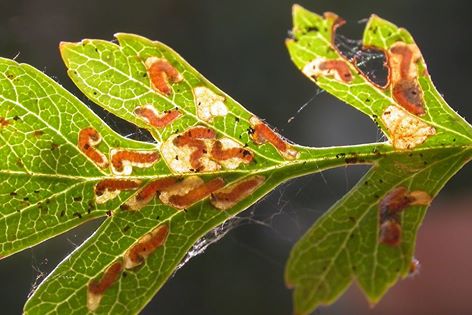 Mines of Scythropia crataegella on Crataegus Image: Ben Smart |
|
Scythropia crataegella (Linnaeus, 1767) [Lepidoptera: Yponomeutidae]. |
3o > Leaf-miner: The young larva mines the leaves of its foodplant then hibernates. It will then mines leaves or flowerbuds, then blossom or leaves. Branched, sometimes stellate, brownish, very transparent, sometimes long corridor that contains no frass. All frass is ejected through a number of tiny openings that generally are close to a vein. Only the young larvae are miners. |
|
Recurvaria nanella (Denis & Schiffermüller, 1775) [Lepidoptera: Gelechiidae]. |
3p > Leaf-miner: Usually a very small (but see below), pear-shaped, upper-surface blotch, most of it stuffed with reddish brown frass. Often several mines in a leaf. Ovipisition is already in May, but the larvae hatch late and initially develop very slowly; only against the end of summer the mines become apparent. The larvae remain in the mine and hibernate in the fallen leaves. The bright-coloured frass and their large number makes these mines very conspicuous in autumn, despite their small size. The weevils feed pinhole-sized windows in the leaf upperside (maturation feeding). |
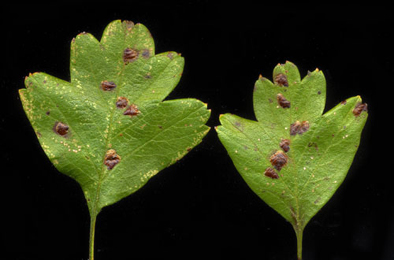 Minee of Rhamphus oxyacanthae on Crataegus monogyna Image: © Willem Ellis (Bladmineerders van Europa) |
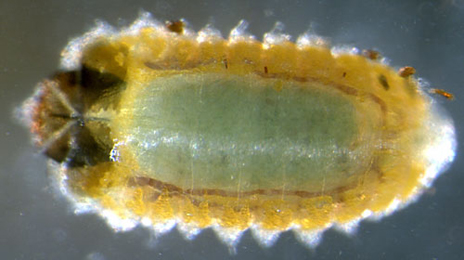 Rhamphus oxyacanthae larva, dorsal Image: © Willem Ellis (Bladmineerders van Europa) |
|
Rhamphus oxyacanthae (Marsham, 1802) [Coleoptera: Curculionidae]. |
3q > Leaf-miner: Egg either at upperside or underside of the leaf. The mine begins as a narrow cooridor, often following a vein or the leaf margin. Later sections of the corridor are mch wider and contorted, mostly forming a secondary blotch. Frass in a narrow central line, sometimes a bit broader towards then end of the mine. Often several mines a a leaf. |
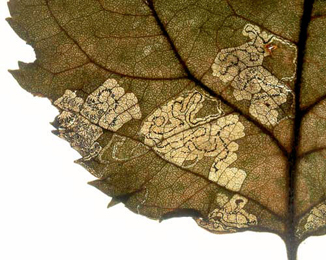 Mine of Stigmella desperatella on Malus sylvestris Image: © Willem Ellis (Bladmineerders van Europa) |
|
Stigmella desperatella (Frey, 1856) [Lepidoptera: Nepticulidae]. |
3r > Leaf-miner: Egg at the underside of the leaf. The mine is a not very strongly contorted corridor, also not limited to a small portion of the leaf, and usually not forming a secondary blotch. Frass black. The frass line is very narrow, especially in the first section of the mine. In the second part the line may be broader, with the frass dispersed or indistinctly coiled, but always the width of the frass remains less than a third of the width of the corridor. |
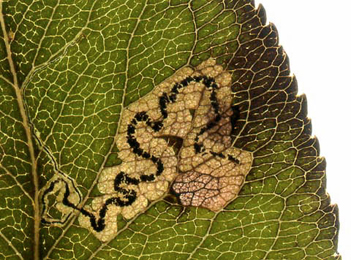 Mine of Stigmella minusculella on Pyrus communis Image: © Willem Ellis (Bladmineerders van Europa) |
|
Stigmella minusculella (Herrich-Schäffer, 1855) [Lepidoptera: Nepticulidae]. |
3s > Leaf-miner: The reddish frass is linear, later in arcs, finally dispersed. Long corridor, that widens only little, and winds freely through the leaf, not influenced by the venation. In thick, sun-exposed leaves the mine may be much shorter, especially in Cotoneaster, Malus and Pyrus. Frass brown, in arcs.. |
|
Stigmella oxyacanthella (Stainton, 1854) [Lepidoptera: Nepticulidae]. |
3t > Leaf-miner: A very contorted gallery. Egg may be at either side of the leaf. Mine a corridor, usually compacted into a small area, sometimes forming a secondary blotch. Frass in the first section of the gallery in a more of less broad central line, clearly coiled in the last part. |
|
Stigmella pyri (Glitz, 1865) [Lepidoptera: Nepticulidae]. |
3u > Leaf-miner: Full depth blotch, invariably beginning at the leaf tip or the tip of a leaf lobe or tooth. Oviposition site covered by a black, shining drop of hardened secretion. Frass generally in long threads, but sometimes in elongated granules. Pupation in the mine, not in a cocoon. |
|
Trachys minutus (Linnaeus, 1758) [Coleoptera: Buprestidae]. |
3v > Leaf miner. The egg is deposited in the base of the midrib. After oviposition the female severes the petiole, causing the petiole to break. The leaf start to wilt and falls, but still remains green for a considerable time. The larva tunnels in the midrib, and makes from there broad, full deep blotches in the lamina. Frass dispersed in the mine. Often several larvae in a leaf. Pupation in the ground. Blommers & Vaal (2002a) and Gønget (2003a) describe the biology in more detail.. |
|
| Neocoenorrhinus pauxillus (Germar, 1824) [Coleoptera: Rhynchitidae]. |
| Last updated 06-Jul-2019 Brian Pitkin | ||

